During the summers, women in Maharashtra’s Nashik rappel down the well and spend hours waiting for water to seep into ditches at the bottom.
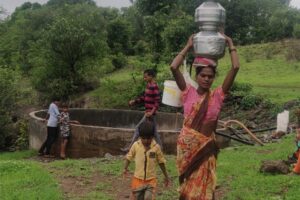
Nashik, India – Two years ago, Leela Pardhi was rappelling down a 60 foot-deep (18 metres) well to fetch water when the rope holding her slipped and she fell into the well, badly injuring her legs and hips. She is still in pain.
That dangerous descent was the only way the 29-year-old find could find water in the hamlet of Bardechi Wadi, in Trimbakeshwar in western India’s Maharashtra state.
“I thank God that I only fell from further down the well and not from the top. I may not have survived,” Leela told Al Jazeera.
She had to see a doctor who prescribed her medication, significant costs for a family that lives off a meagre farming income of less than 50,000 rupees ($674) a year.
Two years later, and in spite of the danger, Leela’s mother-in-law Jaibai and 12-year-old daughter Varsha still descend the well to fetch water for their family.
Leela’s family consists of her 30-year-old husband Sanjay, who is a farmer, their two children aged 12 and 8, and her in-laws.
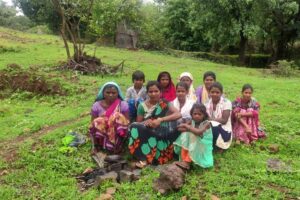
For about five months of summer every year, women belonging to the Thakur caste, one of Maharashtra’s scheduled tribes that most people in the hamlet belong to, rappel down this well and spend hours waiting for water to seep into the ditches at the bottom.
They need the water for daily domestic needs, including drinking.
In drought-struck communities like Bardechi Wadi, fetching water is considered a woman’s responsibility, with the thankless burden affecting their health and economic status and leaving them vulnerable to systemic exploitation.
The ordeal affects the mental and physical health of the women. Two, including Leela, have been injured so far.
‘Women sleep only for one or two hours’
The onerous task can take hours and is mostly done at night. The women have to wait for groundwater to seep out of the well’s dry floor so they can collect it using small bowls.
This seepage can take an hour to fill a pot of water and women may spend four to six hours filling water for a single day’s use.
Cattle have to be taken to a muddy pond far away to drink.
“In summer, I only sleep for a few hours after dinner and then come to the well about 10pm,” says Sunita Pardhi, 30.
“My neighbor and I do this work together where one stays up to hold the torch and pull the buckets up and the other climbs down. Women in this village sleep only for one or two hours in summers.”
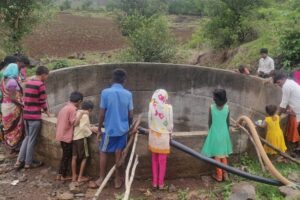
Women climb down the well using iron levels like a ladder. At the last step, which is around the halfway mark, they use the rope tied there to rappel down further. Girls typically wind the rope around their toes and calves, while holding it with their hands and sliding down. But not all women are capable of doing this.
Only 10-12 women in this village know how to rappel down, which means some families have to ask one of these women for help.
“Men think filling water is woman’s job”
Sixteen-year-old student Puja Pardhi has to spend up to four hours a day fetching water for her family of eight.
“This does not mean we are spared other household chores. We have to do those as well,” she told Al Jazeera.
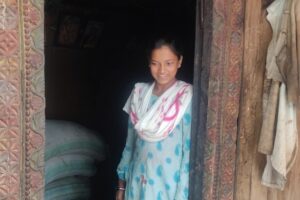
For Bardechi Wadi, water issues have been exacerbated by climate change, political infighting and patriarchal norms. The thought of filling water for the house is demeaning to men.
“Men think filling water is a woman’s job. If a man is seen carrying pots of water, people will laugh at him and ask him if his wife is punishing him for something he did,” said Nivrutti Pardhi, a villager who has been fighting to find a solution to the scarcity.
Farming and farm labor are the primary occupations of the Wadi residents, who rely on monsoon rains for irrigation and can only cultivate one crop a year, usually rice or millet.
The crop is can feed their families, but villagers have no cash for other needs. So, after harvest, many leave for other villages or cities to work as manual laborers.
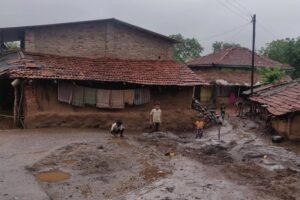
Residents of Bardechi Wadi say the water scarcity that endangers the health and lives of women is due to two reasons: poor water conservation or management, and the apathy of the region’s politicians.
The hamlet is less than 3km (2 miles) away from Middle Vaitarna Dam, one of the dams that supply water to India’s financial capital, Mumbai, 170km (105 miles) away.
Locals can access water from dams for domestic purposes but even so, one trip to the reservoir takes the women an hour one way on foot owing to the difficult terrain.
Poor water management
What the women of Bardechi Wadi need is for that water to be brought to their village instead because the circumstances under which they have to rappel down the well are unique to their village.
The local Take Deogao panchayat (village council) spends up to 150,000 Indian rupees ($2,022) every year on hiring water tankers for this village alone during the peak drought season.
Though the council represents eight villages, but other hamlets such as Dharachi Wadi had a pipeline laid there three years ago, helping to resolve their water scarcity.
In Bardechi Wadi, the well dries up around January or February, after the water that collected during the monsoon is used up. By April, the village begins to face acute water scarcity and is forced to borrow from the neighbouring Vavi village.
But Vavi’s residents often accuse Bardechi Wadi villagers of drawing “too much from their well”.
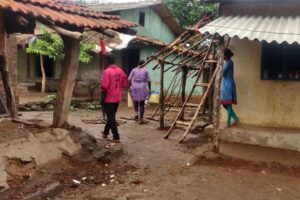
But why do these villages in Nashik’s Trimbakeshwar, which traditionally sees abundant rainfall, suffer from water scarcity? Experts say the answer lies in water management.
“Exploitation of groundwater sources is a major factor here. Nashik has a lot of wells and borewells but it has ‘overexploited blocks’ (regions where groundwater has been over-extracted) possibly due to grapes and onion farming,” Uma Aslekar, senior scientist at the Advanced Centre for Water Resources Development and Management in Pune, told Al Jazeera.
“In Trimbakeshwar range, there is abundant rainfall but the region is categorised by undulating terrain, lack of developed groundwater sources and a tribal population,” she added.
But local Block Development Officer (BDO) Kiran Jadhav believes the area’s groundwater table has been depleting.
“Even though it rains heavily here, the earth’s retention capacity is poor due to rocky topography. In the olden days, groundwater table was better but it has been depleting, possibly due to geological activities such as minor fault or tremors (earthquakes).”
But the problem is not impossible to solve.
After a video of the women’s death-defying feat went viral on social media in 2019, a new pipeline was sanctioned for Bardechi Wadi from a well near the dam.
The water will be drawn from the perennial well and transported through a pipeline to a storage tank in the village. Much of the work on laying the pipeline has been completed.
Hiraman Khoskar, the Maharashtra state assembly legislator from the region, is confident the region’s water scarcity will end but the pipeline is not functional yet. Ancillary works are pending and the village council that is supposed to pay for them is strained for money.
While BDO Jadhav asserted that the shortfall is not a major issue and the pipeline will start working from next year, Leela has her doubts.
“We had to struggle a lot to simply set the wheels in motion to get the pipeline here,” she told Al Jazeera.
“It felt like the administration was waiting for someone to die before they did something. I will believe the work is complete only when I see it with my own eyes.”
Reference:
https://www.aljazeera.com/news/2021/8/24/india-women-water-crisis-nashik-maharashtra-drought
“Pure Water is the World’s First and Foremost Medicine”
